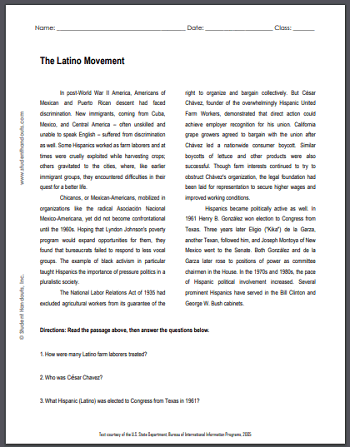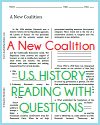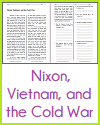| The Latino Movement Reading with Questions |
|---|
| www.studenthandouts.com ↣ American History ↣ American History Readings with Questions |
In post-World War II America, Americans of Mexican and Puerto Rican descent had faced discrimination. New immigrants, coming from Cuba, Mexico, and Central America—often unskilled and unable to speak English—suffered from discrimination as well. Some Hispanics worked as farm laborers and at times were cruelly exploited while harvesting crops; others gravitated to the cities, where, like earlier immigrant groups, they encountered difficulties in their quest for a better life. Chicanos, or Mexican-Americans, mobilized in organizations like the radical Asociación Nacional Mexico-Americana, yet did not become confrontational until the 1960s. Hoping that Lyndon Johnson's poverty program would expand opportunities for them, they found that bureaucrats failed to respond to less vocal groups. The example of black activism in particular taught Hispanics the importance of pressure politics in a pluralistic society.
Chicanos, or Mexican-Americans, mobilized in organizations like the radical Asociación Nacional Mexico-Americana, yet did not become confrontational until the 1960s. Hoping that Lyndon Johnson's poverty program would expand opportunities for them, they found that bureaucrats failed to respond to less vocal groups. The example of black activism in particular taught Hispanics the importance of pressure politics in a pluralistic society.The National Labor Relations Act of 1935 had excluded agricultural workers from its guarantee of the right to organize and bargain collectively. But César Chávez, founder of the overwhelmingly Hispanic United Farm Workers, demonstrated that direct action could achieve employer recognition for his union. California grape growers agreed to bargain with the union after Chávez led a nationwide consumer boycott. Similar boycotts of lettuce and other products were also successful. Though farm interests continued to try to obstruct Chávez's organization, the legal foundation had been laid for representation to secure higher wages and improved working conditions. Hispanics became politically active as well. In 1961 Henry B. González won election to Congress from Texas. Three years later Eligio ("Kika") de la Garza, another Texan, followed him, and Joseph Montoya of New Mexico went to the Senate. Both González and de la Garza later rose to positions of power as committee chairmen in the House. In the 1970s and 1980s, the pace of Hispanic political involvement increased. Several prominent Hispanics have served in the Bill Clinton and George W. Bush cabinets. Directions: Read the text above, then answer the questions below. 1. How were many Latino farm laborers treated? 2. Who was César Chavez? 3. What Hispanic (Latino) was elected to Congress from Texas in 1961? Click here to print. |
 |  |  |  |  |  |
| www.studenthandouts.com ↣ American History ↣ American History Readings with Questions |








